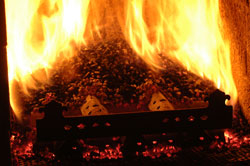 As we enter another heating season, I’m reminded that ultimately we’ll pay just about anything to keep warm in winter. And just because we’ve experienced a period of relatively stable energy prices, it doesn’t mean all is well. Far from it. Instead of breathing a sigh of financial relief and hoping fossil fuel prices stay where they are, we need to make technical changes to our infrastructure while we’ve still got time. This is where a particular form of wood heating can help more than many Canadians realize.
As we enter another heating season, I’m reminded that ultimately we’ll pay just about anything to keep warm in winter. And just because we’ve experienced a period of relatively stable energy prices, it doesn’t mean all is well. Far from it. Instead of breathing a sigh of financial relief and hoping fossil fuel prices stay where they are, we need to make technical changes to our infrastructure while we’ve still got time. This is where a particular form of wood heating can help more than many Canadians realize.
Most Canadians don’t have practical access to firewood nor the space and inclination to store and handle it, but wood heating pellets offer one way around that difficulty. They’re much easier and cleaner to handle than cordwood, and a new Canadian innovation makes it more practical than ever to burn pellets.
Wood heating pellets are made of highly compressed sawdust — typically from reclaimed sawmill waste — but one of the challenges of using them has been the high cost of pellet burning stoves. You can easily pay several thousand dollars for a pellet stove that can only burn pellets – no firewood – and this fact has kept more than a few people from even trying pellets. A guy named Brad Palmer from London, Ontario was one of them, but instead of giving up, he got busy.
Brad is frugal by nature, and that stopped him from forking out thousands of dollars for a pellet stove when he and his wife found conventional wood heating too troublesome and messy. But what about burning wood pellets in their ordinary woodstove? He tried and found that a heap of pellets burned poorly — about the same as a phone book or pile of magazines. The problem was air. It couldn’t get into the heart of the pile, so pellets simply sat there and smoldered. At least they did until he invented an elegant and simple way around the problem.
 After hundreds of hours experimenting with different designs in his home workshop, Brad invented a simple, metal grate — the Bradley Burner — that admits air into a pile of pellets, allowing them to burn cleanly in any ordinary air tight woodstove and fireplace insert. His idea is now patented and for sale online, and I know from personal experience that it works every bit as well as it’s supposed to.
After hundreds of hours experimenting with different designs in his home workshop, Brad invented a simple, metal grate — the Bradley Burner — that admits air into a pile of pellets, allowing them to burn cleanly in any ordinary air tight woodstove and fireplace insert. His idea is now patented and for sale online, and I know from personal experience that it works every bit as well as it’s supposed to.
The Bradley Burner (877-746-7764) is a stacked crisscross of angled metal strips welded together with holes drilled in them. At a cost of $200, this product might seem expensive until you see the thing up close. It’s made of 14 gauge, SS3042B stainless steel that’s TIG welded together to resist warping in the heat. This thick, premium material is the biggest component of the cost. Brad’s early experiments with ordinary steel angle iron proved that this metal was unable to withstand the heat of a wood fire without warping. Heavy stainless steel proved essential.
The triangular shape of each length of stainless steel – plus the perforations along their lengths – allows air to penetrate the pile, enabling the pellets to catch fire and burn cleanly. You pile pellets on top — I find a 2kg or 3kg heap works well to start — squirt some gel fire starter onto the pellets at the front — then light them. The flames slowly work backwards over the next 15 minutes until the whole pile is ablaze. When the initial pile burns down, add more pellets on top of the coals with a metal scoop. Stoked correctly at night, an air tight woodstove or insert will still have burning pellet embers in the morning.
Reducing our dependence on fossil fuels won’t be easy, and it won’t all come from one big change in the way we live. Heating with wood pellets represents one incremental shift in the right direction, and it’s growing in popularity. Pellet heat reduces our reliance on volatile, finite and polluting fossil fuels, it lets us heat without contributing to the greenhouse effect, and it gives more and more people the chance to enjoy an exquisite Canadian wintertime pleasure — snuggling up to a warm, glowing woodstove knowing that neither power failure nor international calamity can threaten the warmth.


